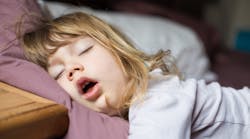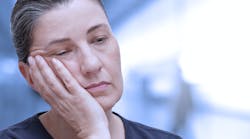LIsten to the article on our podcast!
Cases of sleep-disordered breathing (SDB)—particularly obstructive sleep apnea (OSA)—and attention deficit hyperactivity disorder (ADHD) can present with overlapping symptoms. As dental hygienists, we have the opportunity to identify symptoms of SDB in both children and adults. This article will speak directly to the pediatric population as this subject warrants emphasis across all of health care.
What is sleep-disordered breathing?
SDB encompasses a range of breathing difficulties during sleep, such as mouth breathing, snoring, upper airway resistance, and obstructive or apneic events. In OSA, the upper airway becomes partially or completely blocked, leading to pauses in breathing and disrupted sleep patterns. This not only affects the quality of sleep but can also result in daytime fatigue and cognitive impairment, along with a myriad of health issues.
In the book titled, Treat the Cause … Treat the Airway, Steven Lamberg, DDS, DABDSM, illustrates how snoring and sleep apnea can exacerbate or lead to over 170 medical conditions, including heart disease, kidney disease, dementia, diabetes, acid reflux, insomnia, anxiety, stress, and autoimmune disorders.1 Dr. Lamberg created the Lamberg Questionnaire for Pediatric Airway and Sleep (LQ-PAS) using a patient’s medical history to reveal their risk of sleep-related breathing problems.
What is attention deficit hyperactivity disorder?
ADHD is a neurodevelopmental disorder characterized by symptoms such as inattention, hyperactivity, and impulsivity. While it’s commonly associated with difficulties in focus and behavioral control, recent research suggests a potential connection between ADHD and SDB, particularly OSA.2
There are claims that support one in four children diagnosed with ADHD are being misdiagnosed and thus medicated, which further inhibits sleep quality.3 A sleep questionnaire or assessment is rarely ever conducted on these patients.
Overlapping symptoms in cases of ADHD and SDB may include hyperactivity, behavioral issues, emotional regulation, and difficulty focusing or concentrating. Many of these children do poorly in school and are labeled disruptive to the classroom.
SDB is more common than you might think
According to Dr. David McIntosh, an Australian otolaryngologist, SDB is more common than asthma and diabetes combined.3 Sleep is certainly not something most parents think to discuss at their child’s routine dental appointments.
The general population is not aware that there is a link between poor sleep or airway issues and symptoms that may present in the oral cavity. Some parents may not realize that their child is sleeping poorly or be aware of the impact it could be having on the child’s overall health and well-being. The more you begin to inquire about your patients’ sleep patterns, you may recognize that these symptoms of sleep-related breathing disorders are more common than you had thought.
The American Academy of Pediatrics estimates that sleep problems affect 25%–50% of children and 40% of adolescents.4 A 2012 study, conducted by Dr. Karen Bonuck, revealed that children with sleep-related breathing disorders were from 40%–100% more likely to develop neurobehavioral problems by age 7, compared with children without breathing problems.5 Parents were asked to fill out a strengths and difficulties questionnaire to assess a child’s hyperactivity, emotional symptoms, peer problems, conduct problems, and prosocial behavior.
Researchers believe that sleep-related breathing disorders could cause behavioral issues by “affecting the brain in several ways: decreasing oxygen levels and increasing carbon dioxide levels in the prefrontal cortex; and interrupting the restorative processes of sleep.”5 As a result, children struggle with executive functioning (skills such as planning, goal-setting, self-control, and focus during distraction) and the ability to self-regulate.6
A sleep screening tool
If your dental office’s medical history lacks sleep-related inquiries, I recommend a discussion with your team to incorporate such questions. There is also the pediatric sleep questionnaire (PSQ) that can be given separately. The PSQ is a valid and reliable sleep screening tool that contains 22 symptom items that ask about snoring frequency, loud snoring, observed apneas, difficulty breathing during sleep, daytime sleepiness, inattentive or hyperactive behavior, and other pediatric OSA features. Furthermore, it can be used when polysomnography (a type of sleep study) is not feasible.5
Questions to ask your patients
Consider including these questions on your medical history intake forms:
- Does your child snore?
- Are there witnessed apneas?
- Does your child toss and turn?
- Does your child grind their teeth?
- Does your child sleep talk, sleepwalk, or have night terrors?
- Does your child sleep in strange positions?
- Does your child frequently wet the bed?
- Does your child breathe through their mouth?
By asking these simple questions, we can initiate potentially lifesaving conversations with our patients. Not all families may be ready to act at that very moment, but you are certainly providing information for further thought and observation. It may be surprising at the six-month recare appointment how many families return and mention they had discussions with their pediatrician or ENT physician regarding a more thorough investigation.
SDB and its effects on oral health
Dental hygienists play a vital role in promoting oral health and overall well-being. Integration of an SDB screening into medical histories adds yet another dimension to dental client care. The health of the oral cavity, craniofacial growth and development, and quality of sleep are interconnected. Oral manifestations may present such as bruxism, dry mouth, enlarged tonsils or uvula, scalloped tongue, dental crowding, gingival inflammation, and periodontal disease.
Dental hygienists are uniquely positioned to identify signs of these conditions during routine dental exams. Studies suggest that up to 80% of individuals with OSA are undiagnosed. By incorporating simple screening tools into their practice, dental hygienists can help identify patients at risk and facilitate timely referrals for further evaluation and management. By screening for SDB, dental hygienists can foster interdisciplinary collaboration with physicians, sleep specialists, and other health-care providers. This collaborative approach ensures comprehensive patient care and facilitates the integration of oral health into the broader context of overall health and wellness.
Editor's note: This article appeared in the April/May 2024 print edition of RDH magazine. Dental hygienists in North America are eligible for a complimentary print subscription. Sign up here.
References
- Lamberg S. Treat the Cause … Treat the Airway: The Role of Snoring and Sleep Apnea in Contemporary Preventive Medicine. SleepWell Publishing; 2020.
- Urbano GL, Tablizo BJ, Moufarrej Y, Tablizo MA, Chen ML, Witmans M. The link between pediatric obstructive sleep apnea (OSA) and attention deficit hyperactivity disorder (ADHD). Children (Basel). 2021;8(9):824. doi:10.3390/children8090824
- Woodward C. ADHD misdiagnosis crisis: “Condition more common than asthma and diabetes combined” being mistaken for disorder. 7 News. June 8, 2023. https://7news.com.au/lifestyle/health-wellbeing/adhd-misdiagnosis-crisis-condition-more-common-than-asthma-and-diabetes-combined-being-mistaken-for-disorder-c-11454019
- Sleep health. Children’s Airway First Foundation. https://www.childrensairwayfirst.org/sleep-health-for-kids
- Chervin RD, Hedger K, Dillon JE, Pituch KJ. Pediatric sleep questionnaire (PSQ): validity and reliability of scales for sleep-disordered breathing, snoring, sleepiness, and behavioral problems. Sleep Med. 200;1(1):21-32. doi:10.1016/s1389-9457(99)00009-x
- Bonuck K, Freeman K, Chervin RD, Xu L. Sleep-disordered breathing in a population-based cohort: behavioral outcomes at 4 and 7 years. Pediatrics. 2012;129(4):e857-e865. doi:10.1542/peds.2011-1402










